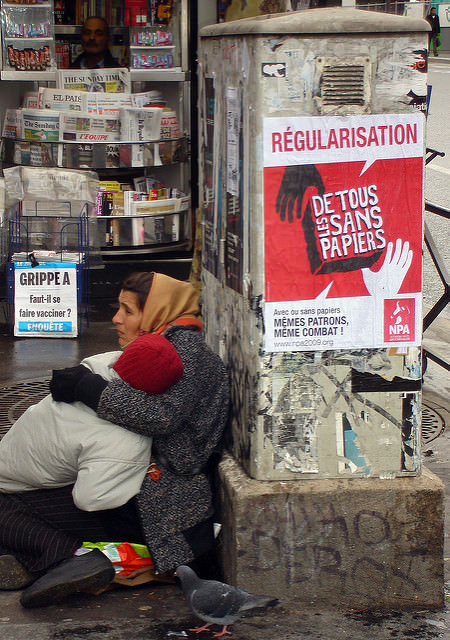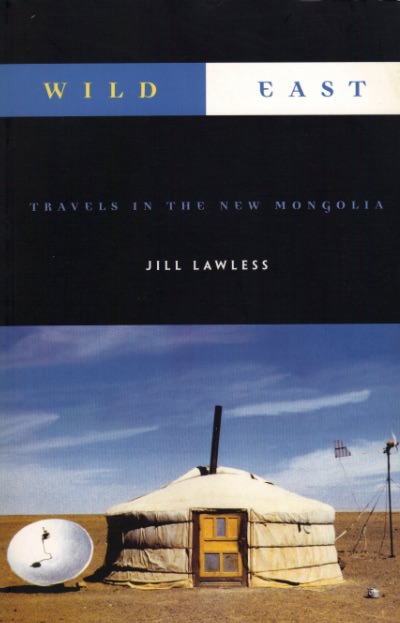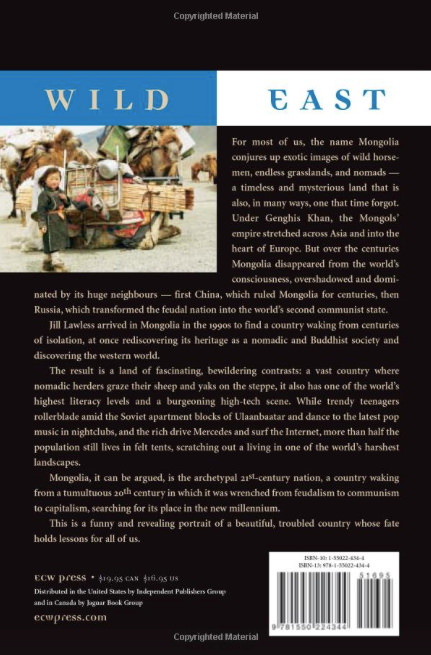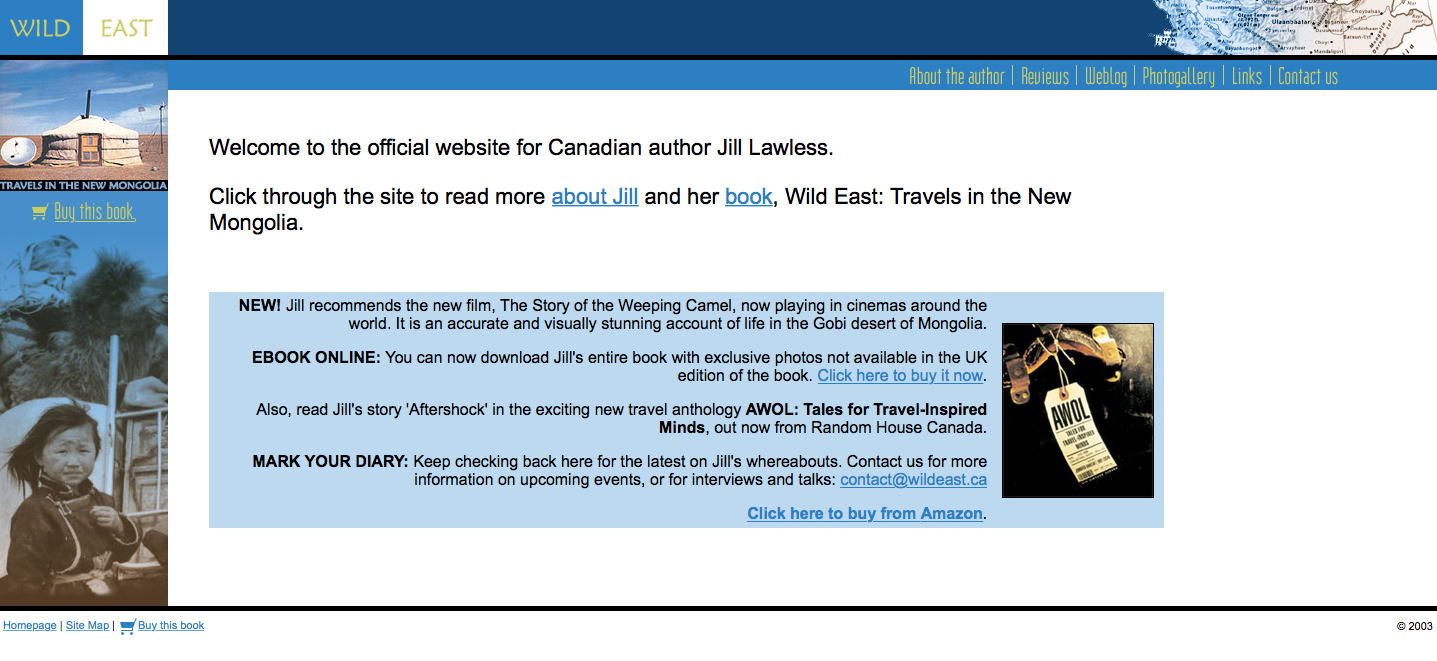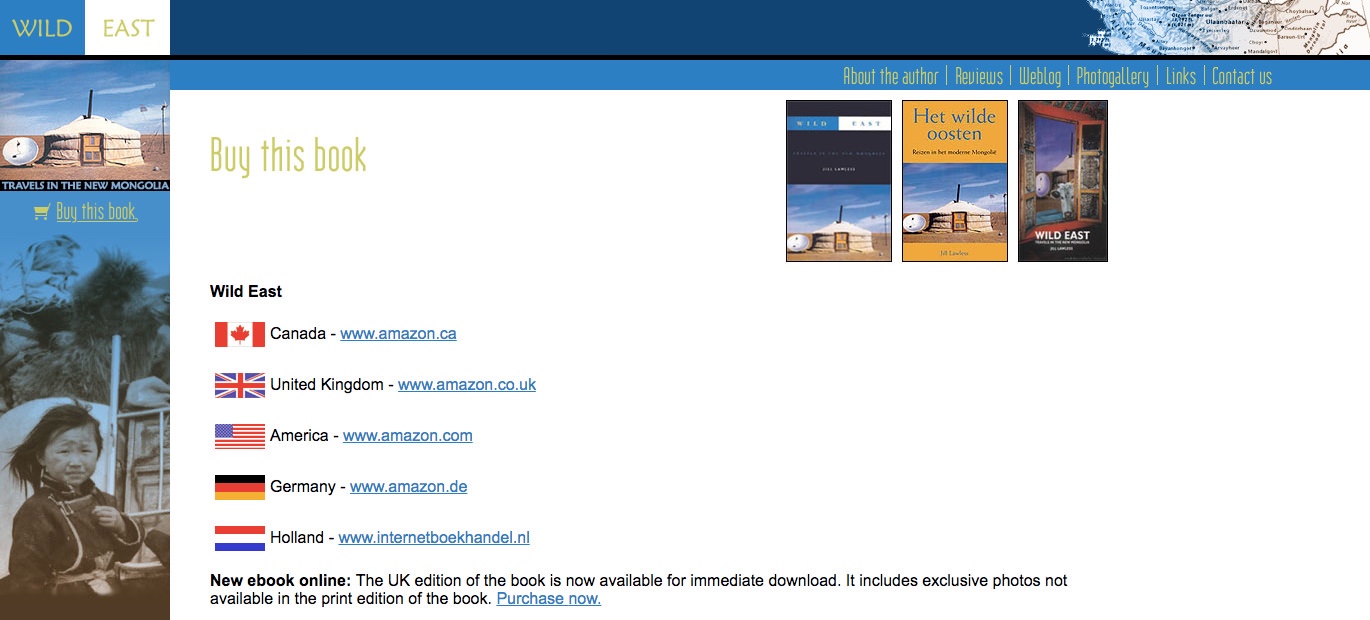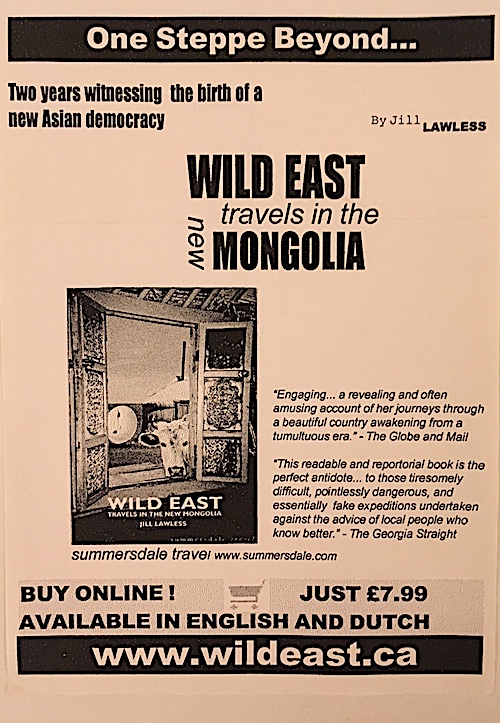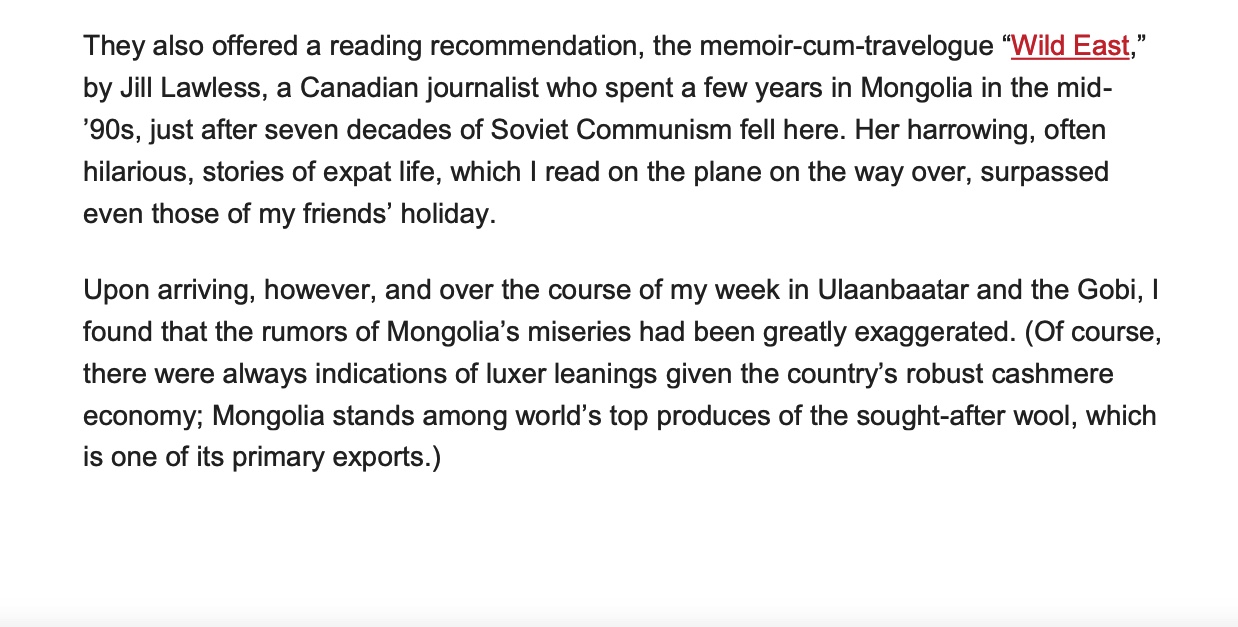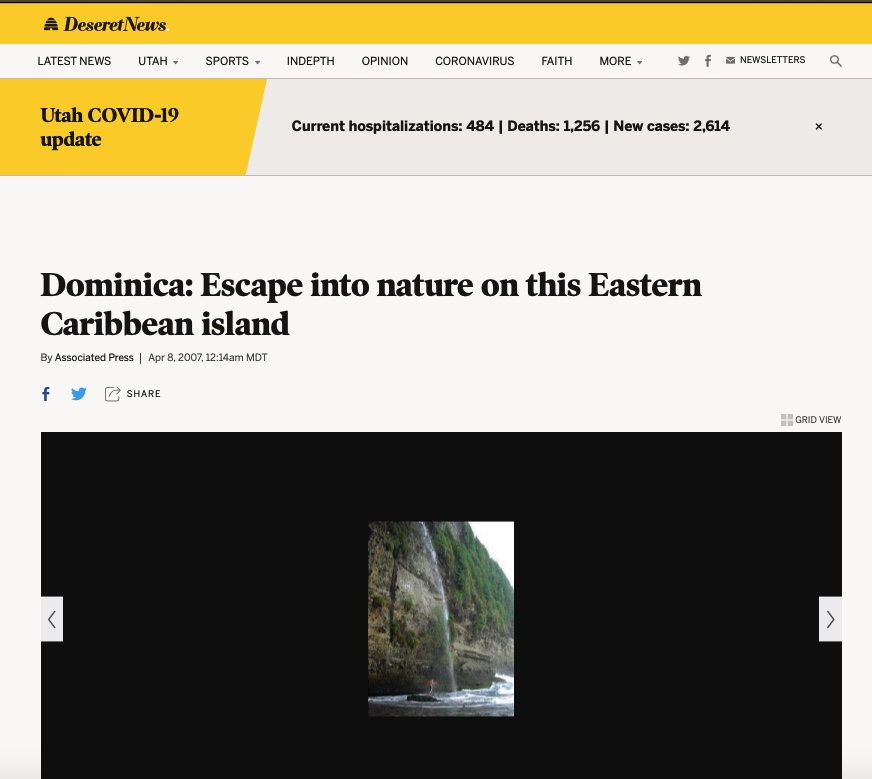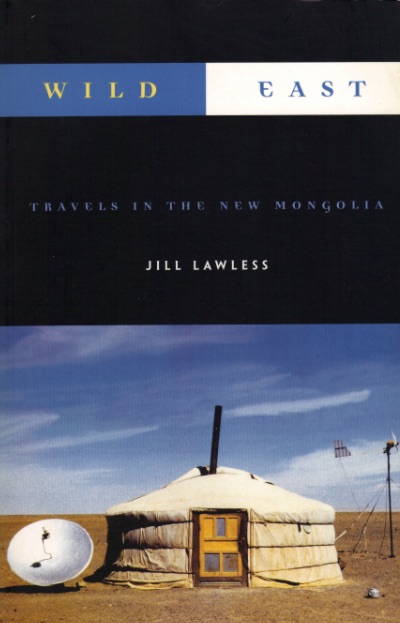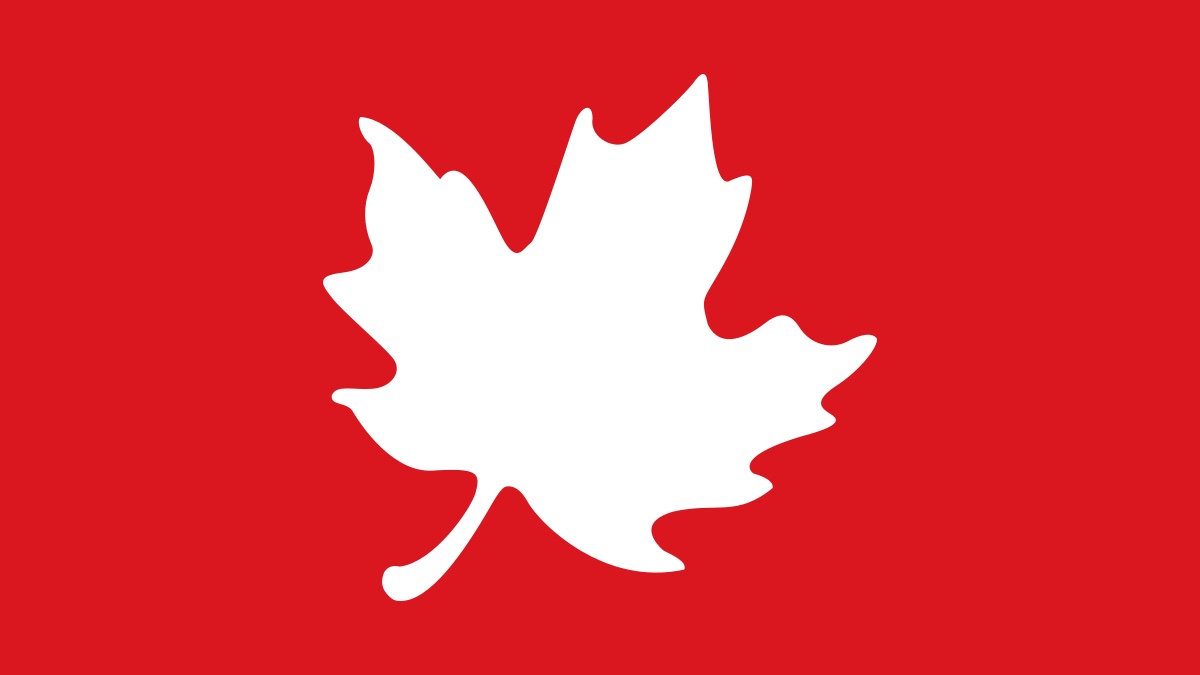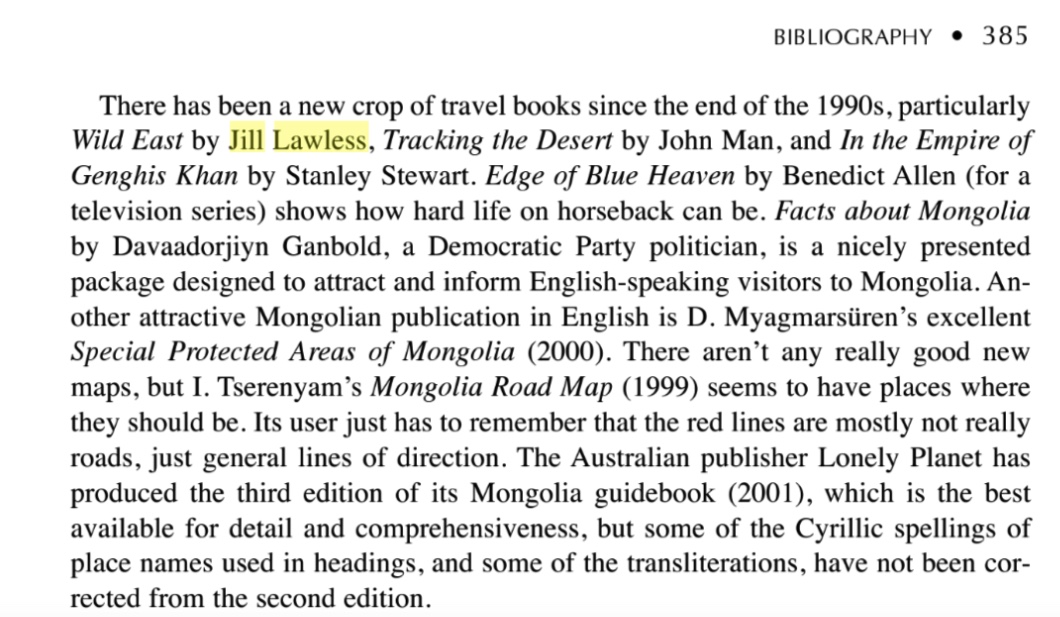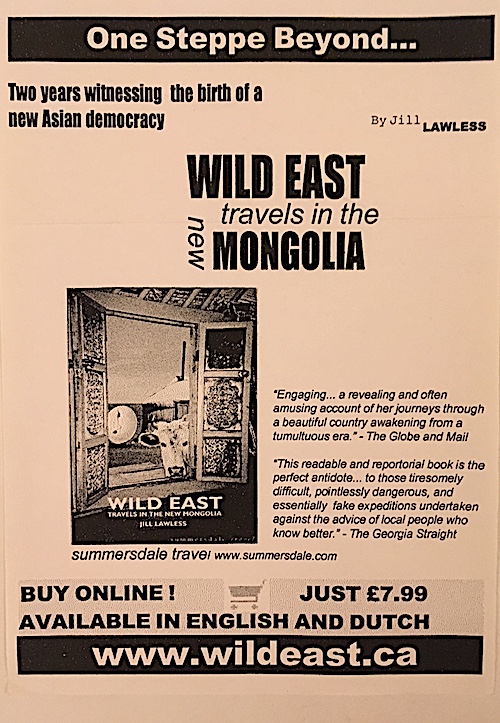Paper delivered to the School of Politics and Government, Birkbeck College, University of London, London, UK, 2000
“... the neo-liberal claim that transition is most successful in situations where state organs wither away is highly problematic. The state, it seems, is required as a fundamental regulatory formation in transition (Pickles and Smith 1998: 15).”
By David South
This paper will explore the profound weaknesses of economic liberalisation as a tool of poverty reduction in the developing world. I have chosen to explore the experience of the Northeast Asian nation of Mongolia; a country sandwiched between Russia and China which has been held up as an example of how economic liberalisation policies and strong personal freedoms can help a country make the transition from a command-based Communist country to free markets and democracy (UNDP Mongolia: The Guide 1997-1999). I argue that the slate of policies that constitute economic liberalisation (or “shock therapy”) in the 1990s - privatisation, price liberalisation and a free-floating currency - are, by themselves, poor mechanisms for the alleviation of poverty; that in fact they increase poverty rates and leave a legacy of weak institutions that are either unwilling to or incabable of helping the poor. The author will also draw on firsthand evidence gained while working in the United Nations mission in Mongolia for two years.
Economic liberalisation policies have been inhibited from alleviating poverty by the cultural legacy of Mongolia’s economic development, which has de-emphasised private property and a money-based economy and placed a high emphasis on wealth being held in herds of animals and goods exchanged by barter.
Mongolia, with its relative isolation and small population of 2.4 million (Human Development Report Mongolia 2000: 55), has been seen as a self-contained petri dish by economic liberalisers hoping to incubate a robust transition to free markets and democracy that can serve as an example to other post-Communist states.
Mongolia’s journey towards neo-liberal ideas is unique. Unlike many other developing nations, Mongolia’s lively democratic movement that emerged at the end of the 1980s actively sought out these policies, and has enjoyed strong and widespread public support for them (though this has ebbed and flowed with the economic fortunes of the country). The 1996 election was fought and won by the Democratic Coalition based on these policies; the Coalition won 50 of the 76 seats in Mongolia’s parliament, and voter turnout was more than 90 per cent (Far Eastern Economic Review 1997: March 27). Thus, this is not a case of international institutions forcing upon a country policies against its wishes: the door was opened and the economic liberalisers were effectively invited in for a big bowl of fermented mare’s milk.
However, it is also a country in which economic liberalisation has failed to deliver anticipated reductions in poverty for the majority of the population, and a strong case exists that it has made things worse.
As the Human Development Report Mongolia 2000 states:
In recent years however, the predominant vision has been neo-liberal. Backed by some international donors, reformers have argued that the best thing the state can do is to largely withdraw from the economy - by rapidly privatising state enterprises, and dismantling as many regulations and controls as possible, and allowing market forces to determine the production and allocation of goods and services. (Human Development Report Mongolia 2000: 13)
Liberalisation policies in Mongolia: A potted history
With the fall of the Soviet Union at the beginning of the 1990s, Mongolia woke up to find itself without its financial benefactor for most of the 20th century, Russia, and in the grip of a severe economic decline (Rossabi 2000: 9).
But a new “big brother” was at hand. In 1991, economic liberaliser Jeffrey Sachs arrived in Mongolia (Fortune 1998: December 7). The arrival of Sachs and his ideas were to have a profound impact on the lives of Mongolians. He gathered a group of well-educated Mongolian economists to test economic liberalisation theories.
Smith and Swain neatly summerise the source of economic ideas for the transition states:
The roles played by Francis Fukuyama (1992), formerly of the US State Department, and Jeffrey Sachs (1990), as policy adviser … translated this agenda into the all too familiar programme of so-called ‘shock therapy’. Shock therapy has been based on the view that capitalism could be … imposed by fiat and that the unleashing of the power of capital will inevitably allow the institutions, regulations, habits and practices associated with the ‘normal’ functioning of a capitalist market economy to emerge (Smith and Swain 1998)
The economic liberalisation project in Mongolia can be split into two distinct phases. The first more tentative phase under the Communist government extended from 1990 to 1992 and included privatisation of some state firms, the issuing of stock-market vouchers to most of the population and a failed attempt to enter the foreign currency markets (as a result of which 80 per cent of the country’s reserves were lost). This phase coincided with a new constitution, democratic elections and significant improvements in personal freedoms.
The economic liberalisation project encountered serious difficulties from the start, and when all aid and subsidies from the Soviet Union were removed, the economy collapsed, with inflation spiralling to 320 per cent (Human Development Report Mongolia 2000: 13). Pro-economic liberalisation factions in the Communist government lost influence and the reforms stalled from 1992 until 1996, when they were re-started with a vengeance with the election of the Democratic Coalition. The Coalition was assembled from a hitherto fragmented opposition by the Washington-based International Republican Institute and mimicked the policies of the American Republican Party, including distributing a Newt Gingrich-style “Contract with the Mongolian Voter.”
The second phase of reforms, under Democratic Coalition Prime Minister M. Enkhsaikhan, was launched with the removal of price controls on fuel and electricity, increasing prices by 50 per cent (Rossabi 2000: 11). This phase of economic liberalisation also ran into difficulties, but its most successful policy achievements have been the privatisation of public housing, the removal of trade tariffs and the reining in of inflation.
Poverty and economic liberalisation
Prior to the introduction of economic liberalisation, there was no extreme poverty in Mongolia, though it is difficult to gauge relative poverty since this information was not gathered. Rossabi notes, however, an extensive public welfare system was spread throughout the country:
The Mongol economy required substantial subsidies from the Soviet Union. This command economy produced inefficient industries, few consumer goods, and scant increases in the size of the Mongol herds. The one-party system limited dissent and contributed to human rights abuses. On the other hand, the government provided extensive medical, educational, and welfare benefits to the young, women, the elderly, and indeed much of society. A growth in population, a longer life span, and high rate of literacy were byproducts of such state policies. (Rossabi 2000: 6)
All research data has shown an increase in poverty levels for a large portion of the population after 1990. Estimates vary wildly, but the United Nations Development Programme reports that 38.4 per cent of urban dwellers - and 32.6 per cent of rural residents - were poor in 1998 (Human Development Report Mongolia 2000: 23). School attendance is down, regional disparities have become more extreme, with the capital experiencing a boom fuelled by international aid (this totalled US $180 million in 1998 (Mongolia Update 1999: 27) and an expanding service sector. Provincial towns and smaller communities have seen local state-run businesses collapse, communications weaken, and a leaching of the population, either to the countryside to herd animals or to the capital to seek work.
To cite one graphic anecdotal example of the process, a consulant for the Asian Development Bank told a 1998 donor agencies meeting of the irony of going into former factory towns, and telling the well-educated residents to turn to small crafts and itinerant vegetable growing rather than restarting the existing factory.
Mongolia’s transition: theoretical dilemmas
As Pickles and Smith note in their work of political economy Theorising Transition: the Political Economy of Post-Communist Transformations, it is a profound mistake to ignore the distinctive evolution of each of the former Communist states. Mongolia’s attempts at transition to a market economy have been deeply marked by its cultural legacy, in spite of attempts to transcend this. While Ohmae may assert that “This movement up the ladder of development has nothing to do with culture and everything to do with the region’s ability to put the right policies, institutions, and infrastructure in place at the right time (Ohmae 1994: 21),” culture is crucial. It is simplistic to depend on a “stock set of policies to enable the supposed transition to capitalism at the end of the twentieth century to be achieved (Pickles and Smith 1998: 10).”
As Pickles and Smith add about post-Communist Eastern Europe:
Treating post-communist Eastern Europe as a whole fails to recognise the ever-present diversity of some 27 states and 270 million people. Even at the end of the nineteenth century, such political-economic diversity was central to what was unfolding in the region … The diversity of historical experiences was replicated under state socialism, and while we would not argue for some form of historical determination, the state socialist economy in part relied upon these spatial divisions of labour and forms of social organization and institutionalised practices, albeit that large-scale attempts at forced industrialisation were made to eradicate the legacies of ‘peasant societies’ and uneven capitalist development. (Pickles and Smith 1998: 12)
Historically, Mongolia had never experienced capitalism, even in its most basic and embryonic form. Prior to the 1921 revolution which made Mongolia the world’s second Communist country, the vast majority of its citizens were divided between two occupations: nomadic herding, and the herding of souls as Buddhist monks. There was a small trading community, including a tiny community of Jewish traders - a legacy of the long-gone silk route that once plied its way through the Mongol Empire. But modern, urban, industrial capitalism as was present at this time in Europe was nonexistent in Mongolia. Concepts of capitalism, market economics and private property were introduced anew after 1990.
Urbanisation, modernisation and industrialisation were wholly communist concepts in Mongolia prior to 1990. The traditional nomadic way of life measures wealth in terms of the size of the herd and places a high value on the ability to roam unencumbered by private property divisions and the ability to trade animals for other goods (though these needs are simple since a nomadic herder can only carry around a limited quantity of possessions).
Economic liberalisation policies have, ironically, only exacerbated this trend, driving more of the economy into barter relations and actually pushing a portion of the population out of urban areas and into subsistance herding in order to survive (Partnership for Progress 1998: 2-3).
Mongolia also offers some anomalies to theories of economic and democratic liberalisation. Lewis contends that democracy gives a nation a distinct economic advantage. “Average wealth, the degree of industrialisation and urbanisation and level of education are perceived to be much higher for countries which are democratic, education being of particular importance in this respect (Lewis: 1997).”
Yet as Fortune magazine noted, “No other Asian country enjoys more political freedom today than Mongolia. And no other Asian country has shown greater commitment to open markets. But Mongolia has received little reward for its efforts (Fortune 1998: December 7).”
The role of the state
Broad, Cavanagh and Bello see a strong argument for clear state direction in underdeveloped economies in the beginning stages, before allowing market mechanisms to dominate:
The South Korean economy’s resumption of growth after a brief period of stagnation at the onset of the 1980s and Eastern Europe’s slowdown after rapid growth in the 1960s confirm a more complex truth than the purveyed by free-market ideologues. Communist economies may propel societies through the first stages of development, but further growth into a more sophisticated economy necessitates a greater role for market mechanisms. (Broad/Bello/Cavanagh 2000: 392)
Strong state direction in economic development has been abandoned in Mongolia (it remains to be seen whether the re-election of the former Communist party in the summer of 2000 will alter this), and it can be argued that the over-dependence on market mechanisms has been premature.
In fact, “the neo-liberal claim that transition is most successful in situations where state organs wither away is highly problematic. The state, it seems, is required as a fundamental regulatory formation in transition (Pickles and Smith 1998: 15).”
The absence of this regulation in Mongolia means that where once economic transactions were transparent, they have now gone underground. The example of cashmere exports (one of the country’s major foreign-currency earners) is particularly interesting. In 1998 the Mongolian government, faced with ever-dwindling tax revenues, introduced a tax on cashmere exports, ostensibly to protect the domestic cashmere-manufacturing industry. Whatever the true intention, the result was catastrophic for government revenues. Recorded exports fell by more than 98 per cent, to US $306,000 in 1998 from US $16 million in 1997 (Far Eastern Economic Review: 1999). The trade went underground and a handful of customs officials could not make a dent in a border as vast as Mongolia’s. It is a graphic example of how weak the central government had become, unable to raise revenues when necessary.
Economic liberalisation also tends to pull economic activity into the capital, as has been witnessed across the transition states. Centrifugal forces leave great swathes of poverty in rural areas and drain marginal urban centres of their skilled workers (Pickles and Smith 1998: 17). Mongolia is no exception to this pattern (Rossabi 2000: 10).
Forces outside the market
After investigating the role of economic liberalisers in non-communist developing nations, Robert Bates found that market-oriented economists routinely overlook the role politics and political power play in wealth distribution:
One reason that market-oriented economists tend to deny the centrality of politics to the development process is that they tend to discount problems of distribution. Those who adhere to the efficiency-and-growth position counter that if development produces a maldistribution of income, those who are losers in the short run could become winners in the longer run … From this viewpoint, governments are not just irrelevant to the development process, the actually impede it. (Bates 1988: 239-240)
There is scant contemporary research into the role of clan or family elites in modern Mongolia, but Rossabi, a Mongolia historian, believes they wield significant influence to this day, and have glided from communism to capitalism with ease (Rossabi 2000: 12). He asks, “Has there been sufficient turnover in the political elite, or does it represent the same consitutency as in the past? Has it expanded sufficiently to make itself more broadly representative of the Mongol population, including the herders and the countryside in general?”
In search of a purpose
Mongolia today is undergoing a basic economic dilemma familiar to Ricardo. It is at once transforming political and economic relations while also exploring what advantages it has to offer to the world markets, that old chestnut of absolute and comparative advantage. To date, its absolute advantage has been to be the source of raw materials, the two key foreign currency earners being copper and cashmere wool (Human Development Report Mongolia 2000: 30).
Its large herds of animals (some 34 million) are under-utilised as foreign-currency earners, and for the most part provide food for domestic consumption. One of the main reasons for this has been the rudimentary livestock techniques that exclude these vast meat and dairy resources from foreign markets (while the herds are raised without any use of chemicals, there is no quality control - a service once provided by the state before 1990). The distortions to the economy caused by these policies are highlighted in the Gross Domestic Product (GDP). In 1985, agriculture accounted for 14.3 per cent of GDP, and industry was 31.8 per cent. By 1998, agriculture (now mostly nomadic herding) accounted for 32.8 per cent of GDP and industry shrank to 24.1 per cent (Human Development Report Mongolia 2000: 56). The economy had contracted and was more focused on meeting basic domestic food needs.
Mongolia has a number of strengths it can draw on, however, with its impressive steps at building democracy and personal freedom chief among them. Lewis categorises former communist states into two groups, with group two taking an undemocratic route. Mongolia would rank in group one, since these countries have: “relatively rapidly established a reasonably viable constitutional order and multiparty system, having held free elections, seen unequivocal changes of government and generally established civil liberties (Lewis: 1997).”
The economic model used by the Democratic Coalition was the United States; Mongolia’s new leaders, dismissed other Asian nations - with their stoic, thrifty populations taking direction from the state - as poor examples for Mongolia. Like the US, Mongolia’s nomadic heritage values freedom and individual effort over the state, assert government advisers such as Tserenpuntsag Batbold, an economic adviser to the Mongolian prime minister’s office.
Batbold is sanguine about finding a purpose for the country’s economy: “I’m always thinking about this, but I can’t give you an answer. This is exactly why we have to create a nondistortive economic environment, one which will show us the true comparative advantages of this nation (Asian Wall Street Journal 1997: May 27).”
Yet the process has been a difficult one. At a June 1998 international investors’ conference in Ulaanbaatar, the World Bank variously called Mongolia the “gateway to Russia”, the “gateway to China”, and the “gateway to Central Asia” (UB Post: 1998), giving the impression that both the global institutions and the Mongolian government would try anything in a desperate search for a purpose for the country’s economy. In fact, efforts in the 1990s to attract foreign direct investment (FDI) have not been fruitful. In 1999, FDI stood at US $70 million; it was US $200 million for all of the 1990s (Human Development Report Mongolia 2000). The belief that foreign private companies would pay for the country’s infrastructure improvements has run up against a wall: most foreign companies find it hard to see the benefits in investing in a country that only has a market of 2.4 million people and very high start-up costs.
By 1998, even Sachs was striking a pessimistic note. He told Fortune magazine he disagreed with the pace of reforms and insisted infrastructure improvements - more roads, improved livestock breeding, investment in information technology - were the only things that would improve the country’s economy (Fortune 1998: December 7).
Conclusion
Political power in Mongolia has switched from the hegemonic control of the Communist Party (and its overlords in Moscow) to be dispersed amongst a plethora of actors, including international aid organizations. Economic liberalisation has destroyed the state’s ability to guarantee a minimum standard of living. However, it has also expanded the number of small businesses in the country, and the GNP generated from the private sector has grown from 10 per cent of the total in 1990 to 64 per cent in 1999 (Human Development Report Mongolia 2000: 31). In spite of this, poverty rates remain stubbornly high, undermining assertions that free markets alone will generate wealth for the disadvantaged.
Unfortunately, Mongolia has significantly misdiagnosed the origins of prosperity in its current role model, the United States. Economic liberalisation policies cling to simplistic notions of the evolution of capitalist markets in the US, ignoring the complex relationship between state-funded or regulated infrastructure development and economic growth. Post-communist countries have been ill-advised on what policies will actually reduce poverty rates. These societies do not fit into conventional ideas of underdevelopment; on the whole their populations are highly literate and skilled. While products produced by these countries may not be able to compete head-on with more technologically sophisticated equivalents in Western markets, there is little evidence that wholesale destruction of these industries will spurn economic growth and reduce poverty.
 Thursday, October 26, 2017 at 12:34PM
Thursday, October 26, 2017 at 12:34PM 
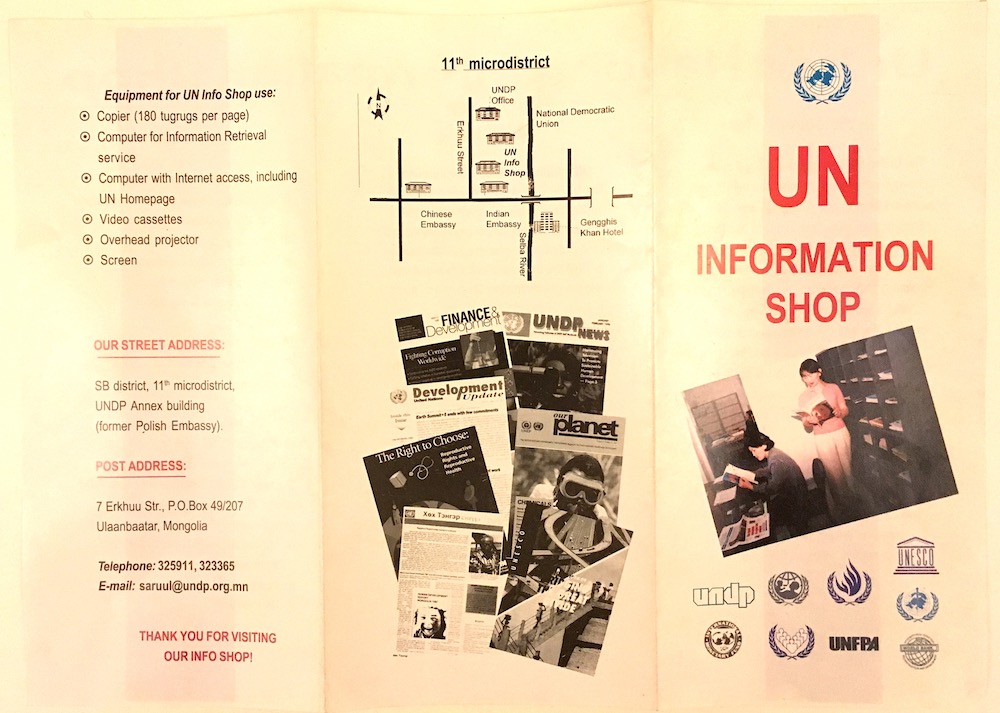 P. Dagmidmaa reads the Human Development Report Mongolia 1997 in the UN Info Shop.
P. Dagmidmaa reads the Human Development Report Mongolia 1997 in the UN Info Shop.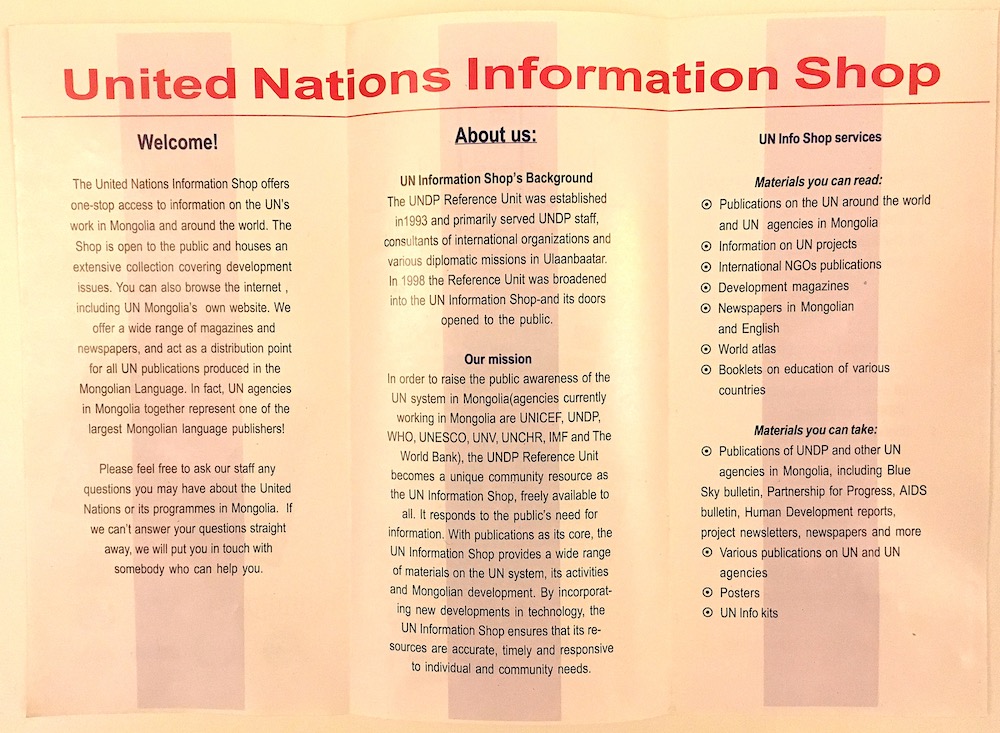
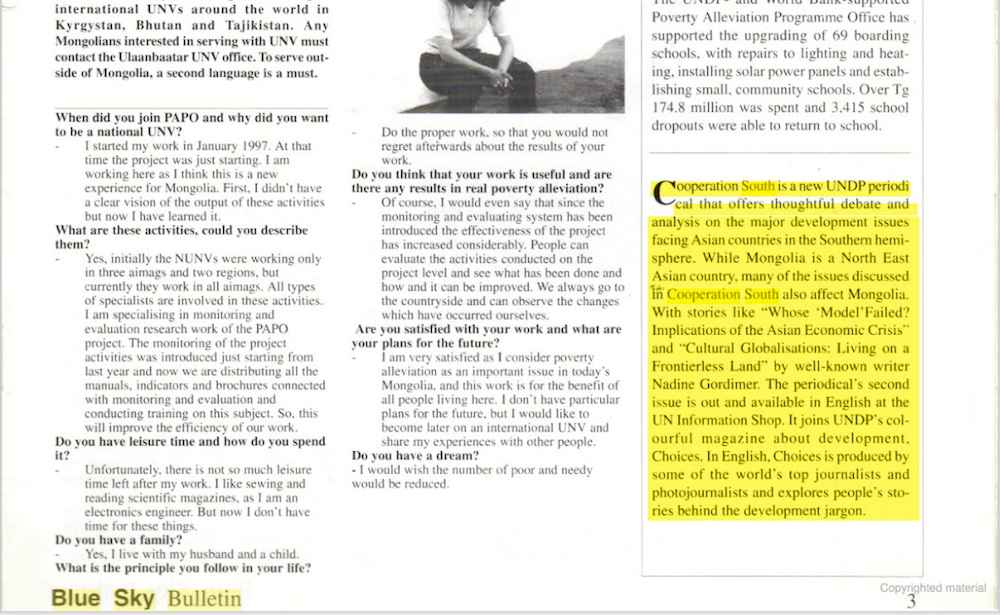 An announcement in the Blue Sky Bulletin about the launch of the new journal Cooperation South.
An announcement in the Blue Sky Bulletin about the launch of the new journal Cooperation South.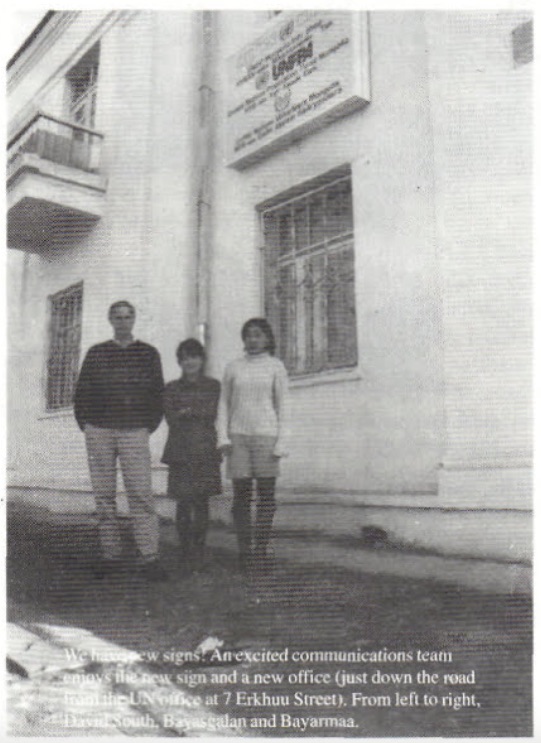 The UNDP Mongolia Communications Office Team 1998 outside the UN Info Shop in the capital, Ulaanbaatar: David South, Bayasgalan and Bayarmaa.Many initiatives grew from the talented and dynamic UNDP Mongolia Communications Office team. Here are links to some of them:
The UNDP Mongolia Communications Office Team 1998 outside the UN Info Shop in the capital, Ulaanbaatar: David South, Bayasgalan and Bayarmaa.Many initiatives grew from the talented and dynamic UNDP Mongolia Communications Office team. Here are links to some of them:  1998,
1998,  Communism,
Communism,  Mongolia,
Mongolia,  Ulaanbaatar,
Ulaanbaatar,  United Nations Information Shop,
United Nations Information Shop,  austerity,
austerity,  capitalism,
capitalism,  crisis,
crisis,  democracy,
democracy,  free markets,
free markets,  shock therapy,
shock therapy,  transition in
transition in  Agenda 21,
Agenda 21,  Asian Financial Crisis,
Asian Financial Crisis,  Corruption,
Corruption,  David South Consulting,
David South Consulting,  Digital,
Digital,  Douglas Gardner,
Douglas Gardner,  Geopolitics,
Geopolitics,  Health and Human Development,
Health and Human Development,  ICT4D,
ICT4D,  International Development,
International Development,  Knowledge Sharing,
Knowledge Sharing,  Media,
Media,  Millennium Development Goals,
Millennium Development Goals,  Nobel Peace Prize,
Nobel Peace Prize,  Shock Therapy,
Shock Therapy,  UNDP Mongolia,
UNDP Mongolia,  Youth
Youth 
